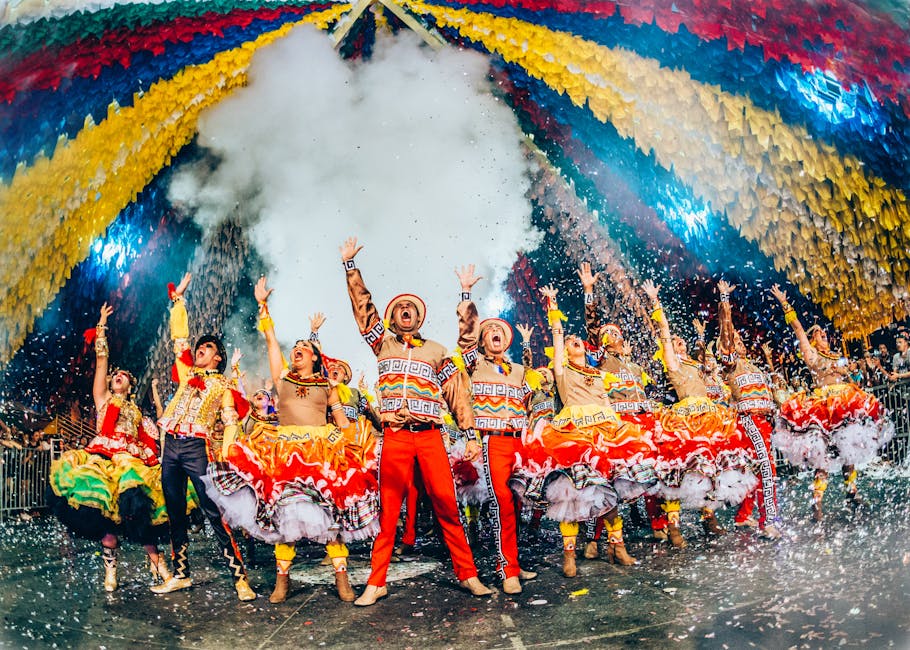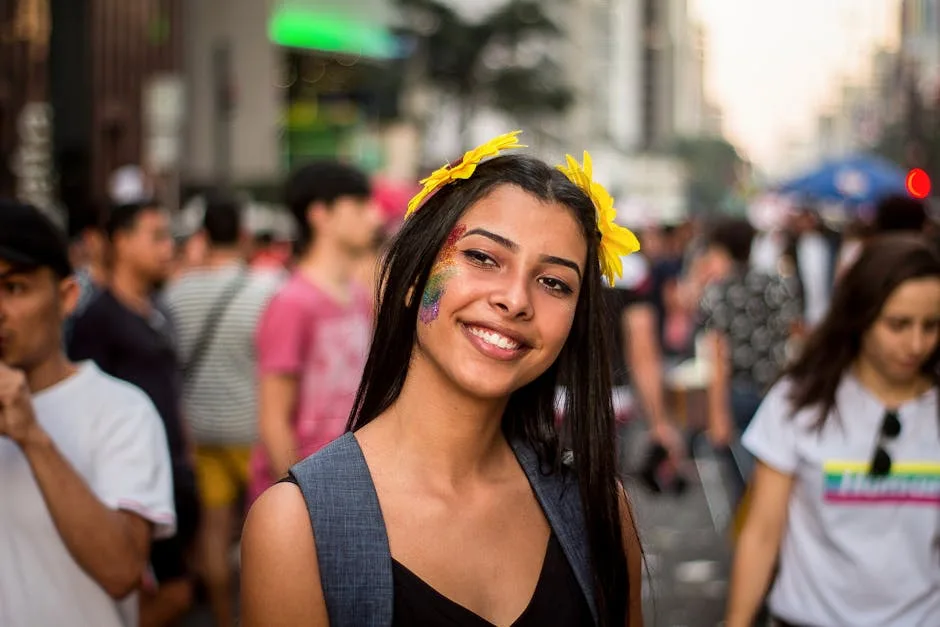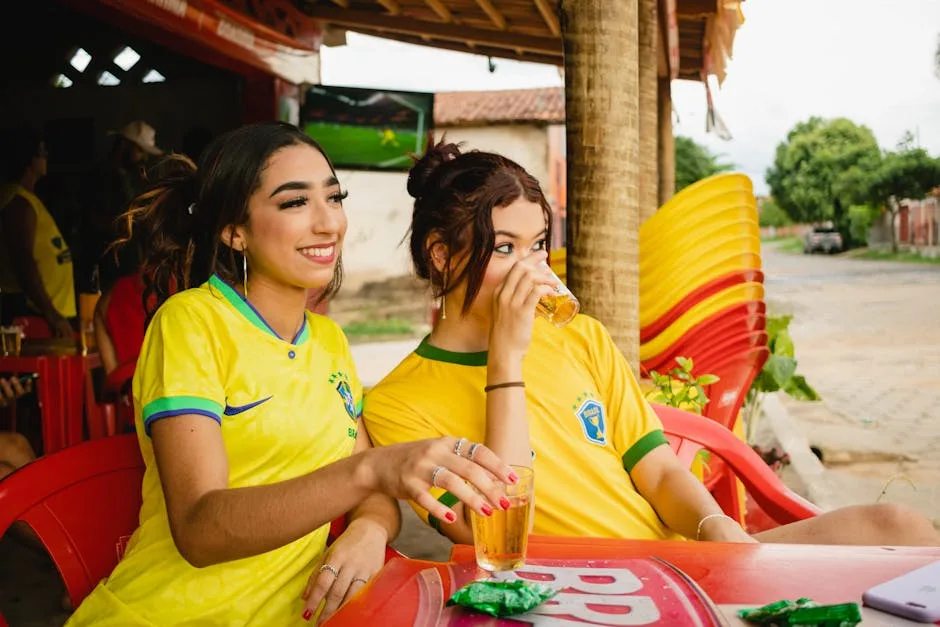- Joyful Junina Celebrations: Brazil's Heartwarming Mid-Year Party
- A Taste of Tradition: Foods, Bonfires, and Quadrilha
- Regional Flavors of Festa Junina
- Devotion and Grandeur: Iconic Religious Processions
- Círio de Nazaré: A Sea of Faith in Belém
- Lavagem do Bonfim: Bahia's Spiritual Washing
- Echoes of the Amazon: Folklore and Epic Rivalries
- Parintins Folklore Festival: The Boi-Bumbá Spectacle
- Beyond the Arena: The Spirit of Boi-Bumbá
- Rhythms of Resilience: Afro-Brazilian Heritage on Display
- Congada and Moçambique: Drumming for Saints
- Maracatu and Frevo: Pernambuco's Vibrant Pulse
- A European Twist and Other Regional Delights
- Blumenau Oktoberfest: Bavaria in Southern Brazil
- Festa do Divino Espírito Santo: Community and Devotion
- Local Fiestas: Unearthing Hidden Gems
- Planning Your Year-Round Brazilian Festival Journey
- Tips for an Authentic Experience
- Respecting Local Customs and Traditions
When you think of brazil, the first image that often springs to mind is the dazzling spectacle of Carnival. And rightly so – it’s an explosion of color, music, and unbridled joy that captivates the world! But to truly understand Brazil’s vibrant soul, you need to look beyond those famous few days in February or March. This incredible country is a tapestry woven with countless traditions, beliefs, and celebrations that unfold throughout the entire year, offering a kaleidoscope of cultural experiences far removed from the samba parades of Rio or Salvador.
Imagine a land where indigenous folklore comes alive in epic theatrical performances, where centuries-old religious processions move millions, and where European heritage is celebrated with exuberant beer festivals. Brazil’s cultural calendar is packed with unique events that reflect its rich mix of indigenous, African, and European influences. Join us on a journey to explore some of Brazil’s most captivating cultural festivals, proving that the party truly never stops!
Joyful Junina Celebrations: Brazil’s Heartwarming Mid-Year Party
As the Southern Hemisphere winter approaches, usually in June (hence ‘Junina’), Brazil ignites with the delightful warmth of Festa Junina (June Festivals). This isn’t just one festival, but a series of regional celebrations dedicated to Catholic saints like Saint Anthony, Saint John, and Saint Peter. Think bonfires, rustic decorations, lively folk music, and some of the most comforting food you’ll ever taste!
A Taste of Tradition: Foods, Bonfires, and Quadrilha
Festa Junina has deep roots in European harvest festivals and Catholic traditions, but Brazil has given it its own unique, charming twist. The atmosphere is undeniably wholesome and communal. Families gather around bonfires (fogueiras), a nod to ancient pagan rituals and later Christian symbolism, sharing stories and laughter. Children don straw hats and painted freckles, dressing up as caipiras (country folk), while adults embrace the rustic, country aesthetic.
The culinary delights are a huge draw, often featuring corn in every conceivable form: pamonha (sweet corn paste), curau (corn pudding), canjica (sweet hominy porridge), and pipoca (popcorn). Peanut dishes like paçoca and pé-de-moleque are also staples. To wash it all down, there’s quentão, a warm, spiced cachaça (Brazilian sugarcane spirit) drink that’s perfect for a cool evening.
The highlight for many is the quadrilha, a traditional square dance reminiscent of European folk dances, but with a uniquely Brazilian flair. Led by a lively caller who shouts commands, participants perform a mock wedding, complete with a nervous bride, a hesitant groom, and a comical priest. It’s a joyful, inclusive dance that anyone can join, regardless of experience, and it perfectly encapsulates the playful spirit of Festa Junina.
Regional Flavors of Festa Junina
While celebrated nationwide, Festa Junina takes on distinct characteristics depending on the region. In the Northeast, particularly in cities like Campina Grande (Paraíba) and Caruaru (Pernambuco), the festivals are enormous, attracting millions and featuring massive stages, elaborate decorations, and endless live music. These are often considered the largest and most vibrant Festa Junina celebrations in Brazil, rivaling Carnival in their scale and enthusiasm. In the Southeast, especially in rural areas, the festivals retain a more intimate, community-focused feel, often held in local churches or schools. No matter where you experience it, Festa Junina is a truly heartwarming and authentic slice of Brazilian life.

Devotion and Grandeur: Iconic Religious Processions
Religious faith runs deep in Brazil, and this devotion often manifests in incredibly elaborate and moving public festivals. These events are not just about spirituality; they are profound cultural expressions, drawing massive crowds and showcasing Brazil’s unique blend of Catholic traditions with indigenous and African influences.
Círio de Nazaré: A Sea of Faith in Belém
Held every October in Belém, the capital of Pará state in the Amazon region, the Círio de Nazaré is one of the largest and most emotional religious processions in the world. Dedicated to Our Lady of Nazareth, it draws over two million pilgrims annually. The central event is the main procession, where a small wooden statue of the Virgin Mary is carried through the streets on a carriage pulled by a massive rope (a corda). Devotees, many barefoot, cling to this rope as a symbol of their faith and gratitude, often moving in a trance-like state.
The atmosphere is a mix of solemnity and joyous celebration. Beyond the main procession, there are river processions, children’s Círio, and a vast fair with regional food, crafts, and music. The entire city of Belém transforms, adorned with lights and decorations, reflecting the deep reverence for Nossa Senhora de Nazaré. It’s an overwhelming, unforgettable experience that beautifully displays the power of collective faith and community in Brazil.
Lavagem do Bonfim: Bahia’s Spiritual Washing
In Salvador, Bahia, the Lavagem do Bonfim (‘Washing of Bonfim’) is a powerful symbol of the syncretism that defines Bahian culture. Held in January, this festival brings together Catholic tradition and Candomblé, an Afro-Brazilian religion. The celebration begins with a procession of thousands of Bahian women, dressed in traditional white lace dresses (roupas de baiana) and carrying ceramic jars filled with scented water and flowers. They walk eight kilometers from the Church of Conceição da Praia to the hilltop Church of Nosso Senhor do Bonfim.
Upon reaching the church, these women ritually wash the steps and forecourt of the church with their perfumed water, singing and dancing to African rhythms. This act is a symbolic purification, an offering to Oxalá (the Candomblé orisha associated with creation and peace), who is syncretized with Jesus Christ (Nosso Senhor do Bonfim). It’s a breathtaking display of faith, history, and cultural fusion, demonstrating how different spiritual paths can intertwine and create something truly unique and beautiful.
Echoes of the Amazon: Folklore and Epic Rivalries
Deep within the heart of the Amazon, a breathtaking cultural spectacle unfolds each summer, showcasing the rich tapestry of indigenous and regional folklore with unmatched theatricality.
Parintins Folklore Festival: The Boi-Bumbá Spectacle
Forget everything you know about festivals, because the Parintins Folklore Festival in Amazonas state is in a league of its own. Held over three nights in late June in the small island city of Parintins, this festival pits two rival groups, Garantido (the red ox) and Caprichoso (the blue ox), against each other in an epic competition. It’s a retelling of the Boi-Bumbá legend, a traditional folk tale about a resurrected ox, infused with indigenous mythology, elaborate staging, dazzling costumes, and powerful music.
Each group has its own ‘Bumbódromo,’ a circular arena where thousands of performers – dancers, singers, musicians, and giant moving floats – put on a spectacular show. The precision, artistry, and sheer scale of the performances are astounding. The audience, divided by color (red for Garantido, blue for Caprichoso), becomes an active participant, singing along and cheering passionately for their chosen ox. It’s a deeply immersive experience, celebrating Amazonian culture, preserving indigenous stories, and creating an atmosphere of friendly yet fierce rivalry that electrifies the entire region.
Beyond the Arena: The Spirit of Boi-Bumbá
While the Parintins Festival is the pinnacle, the spirit of Boi-Bumbá extends beyond this specific event. Throughout the Amazon and parts of the Northeast, variations of the ‘Boi’ legend are performed in smaller, local celebrations. These often feature simplified costumes and performances but retain the core narrative of death and resurrection, blending indigenous spiritual beliefs with European theatrical traditions. These smaller festivals offer a more intimate glimpse into the folk origins of this captivating art form, showcasing the creativity and storytelling prowess embedded in Brazilian regional culture.
Rhythms of Resilience: Afro-Brazilian Heritage on Display
The profound influence of African cultures on Brazil is undeniable, especially in its music, dance, and religious expressions. Many festivals are direct descendants of these traditions, celebrating resilience, faith, and artistic innovation.
Congada and Moçambique: Drumming for Saints
Found primarily in Minas Gerais, São Paulo, and other parts of Southeast Brazil, Congada and Moçambique are vibrant manifestations of Afro-Brazilian heritage. These festivals, often held in honor of Our Lady of the Rosary, Saint Benedict, and other black saints, blend Catholic devotion with African drumming, singing, and dancing. Performers, often organized into ‘irmandades’ (brotherhoods), wear elaborate costumes and carry symbolic weapons, representing the court of the legendary King and Queen of Congo.
The rhythms are hypnotic, driven by drums (like the caixa and tamborim), rattles, and other percussion instruments. The dances are energetic and communal, often involving a ‘cortejo’ (procession) through the streets, stopping at churches and homes. Congada and Moçambique are not just performances; they are living traditions that honor ancestors, preserve cultural memory, and celebrate faith through powerful, uninhibited expression.
Maracatu and Frevo: Pernambuco’s Vibrant Pulse
While often associated with Carnival, the rhythms and traditions of Maracatu and Frevo are integral parts of Pernambuco’s year-round cultural fabric, celebrated in various forms throughout the year. Maracatu Nação, an Afro-Brazilian performance genre, involves a royal court procession, powerful drumming, and dynamic dance, deeply rooted in the history of enslaved Africans and their coronations. Groups, known as ‘nações’ (nations), rehearse and perform regularly, keeping these traditions alive. Witnessing a Maracatu performance outside of Carnival offers a deeper, more reflective appreciation of its historical and cultural significance.
Frevo, a fast-paced, acrobatic dance and music style, is also intrinsic to Pernambuco. Its distinctive brass band sound and the iconic small umbrella used by dancers make it instantly recognizable. While its peak is during Carnival, frevo schools and cultural groups hold events and rehearsals year-round, especially leading up to the main festivities. Many cultural centers and specific ‘blocos’ (groups) host events that allow visitors to experience the infectious energy of frevo at other times of the year, offering workshops and performances that immerse you in its vibrant history.
A European Twist and Other Regional Delights
Brazil’s diversity extends to European influences, leading to unique festivals that might surprise you, alongside countless smaller, local celebrations.
Blumenau Oktoberfest: Bavaria in Southern Brazil
Did you know Brazil hosts the second-largest Oktoberfest in the world, outside of Munich? In the picturesque city of Blumenau, Santa Catarina, settled by German immigrants, October transforms into a vibrant Bavarian spectacle. For weeks, the city celebrates its German heritage with massive beer gardens, traditional food (bratwurst, sauerkraut, pretzels), polka dancing, and parades featuring participants in dirndls and lederhosen.
It’s a testament to Brazil’s incredible melting pot of cultures, showcasing how immigrant communities have preserved and adapted their traditions in their new home. The Blumenau Oktoberfest is a fantastic, unexpected way to experience a piece of Germany in South America, complete with excellent local beers and a lively, friendly atmosphere.
Festa do Divino Espírito Santo: Community and Devotion
Celebrated widely across Brazil, especially in the states of Goiás, Minas Gerais, and the Southeast, the Festa do Divino Espírito Santo (Feast of the Divine Holy Spirit) is a beautiful example of communal religious devotion. Originating from Portuguese traditions, this festival involves a period of prayer, parades, and elaborate banquets hosted by ‘imperadores’ (emperors) or ‘foliões’ (revellers), who are elected annually.
The ‘folias’ are groups of musicians and singers who travel from house to house carrying the flag of the Holy Spirit, collecting donations and offering blessings. It’s a deeply spiritual event, but also a massive community gathering, emphasizing sharing, hospitality, and solidarity. The exact rituals and scale vary significantly from town to town, but the spirit of communal celebration and devotion remains constant, offering a window into Brazil’s enduring faith and local customs.

Local Fiestas: Unearthing Hidden Gems
Beyond these large, well-known festivals, almost every town and village in Brazil has its own patron saint day celebration or harvest festival. These smaller, local ‘festas’ might not draw international crowds, but they offer an incredibly authentic and intimate cultural experience. From simple street parties with local bands and food stalls to small-scale processions and folk dances, these events are where you truly connect with the heart and soul of Brazilian communities. A little research into local calendars can unveil these hidden gems, providing memories that will last a lifetime.
Planning Your Year-Round Brazilian Festival Journey
Ready to venture beyond Carnival and discover the incredible diversity of Brazil’s year-round celebrations? Here are a few tips to make your festival adventure unforgettable:
Tips for an Authentic Experience
- Research and Plan Ahead: Festival dates can vary slightly year to year. Check official tourism websites or local news for precise dates and schedules before you travel.
- Book Accommodation Early: Popular festivals draw huge crowds, so hotels and flights can fill up quickly and prices may increase.
- Embrace the Local Cuisine: Food is an integral part of Brazilian festivals. Be adventurous and try regional specialties, often sold by street vendors or at communal food stalls.
- Learn a Few Portuguese Phrases: While English might be spoken in major tourist hubs, knowing basic Portuguese will greatly enhance your interaction with locals and deepen your experience, especially in smaller towns.
Respecting Local Customs and Traditions
- Dress Appropriately: For religious festivals, modesty is often appreciated, especially when entering churches. For folk festivals, comfortable clothing and shoes are key, as you’ll likely be doing a lot of walking and dancing!
- Be Mindful of Photography: Always ask for permission before taking close-up photos of individuals, especially during religious ceremonies or traditional rituals.
- Support Local Artisans: Many festivals feature local crafts and products. Purchasing from local vendors helps support communities and provides unique souvenirs.
- Stay Hydrated and Safe: Brazil can be hot and humid, and crowds can be large. Drink plenty of water, wear sunscreen, and always be aware of your surroundings, especially your belongings.
Brazil’s cultural festivals offer a profound insight into the nation’s diverse heritage. From the rustic charm of Festa Junina to the spiritual grandeur of Círio de Nazaré, the epic rivalry of Parintins, or the joyful German traditions of Oktoberfest Blumenau, there’s a celebration for every month of the year. So, pack your bags, open your heart, and get ready to experience the true, multifaceted magic of Brazil!





